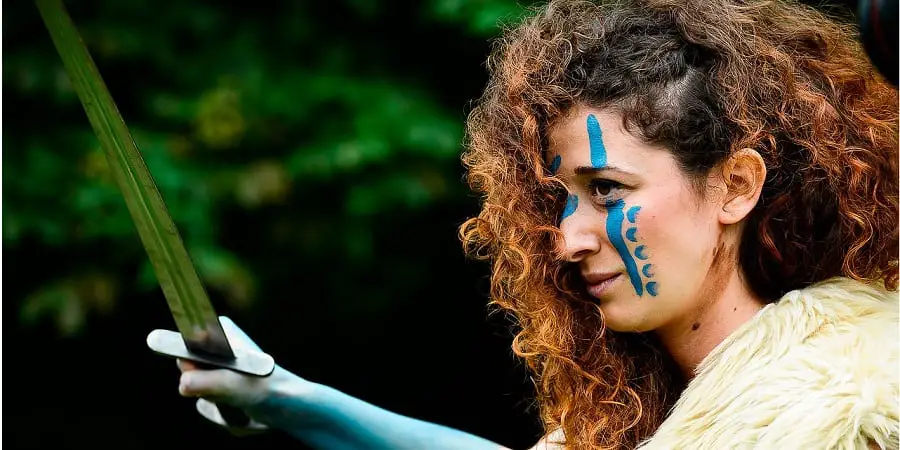Shieldmaidens were female warriors that appear in Scandinavian folklore and mythology. In recent years they have been brought back to life through popular cultures such as the hit TV series Vikings and The popular video game Assasins creed Valhalla.
While there is both historical and some archeological evidence for their existence, experts agree that it is not likely that they were as prominent warriors as popular culture portrays them to be.
Despite this, the legend of a few famous shield maidens remains to this day. Continue reading to learn more about the Viking shield maidens, the evidence for their existence, and the legend of the most famous shield maidens from the Viking age.

Legendary accounts of shieldmaidens
While the Viking society was largely male-dominated, like most societies at that time, Women in the Viking Age enjoyed more freedom and held more power in their society than many other women of their day.
They could own property, request a divorce, and archeological evidence suggest that they could rise to hold important positions in society.
The Sagas and legends also have it that they could be warriors, known as shield maidens. In fact, some sagas contain stories about supposedly famous shield maidens, such as Brunhilda, Lagertha, Hervor, and Viborg.
Lagertha
Lagertha’s tale is recorded by the Christian historian Saxo Grammaticus. According to legends she was a skilled Amazon, who, though a maiden, had the courage of a man, and fought in front among the bravest with her hair loose over her shoulders.
Legends also have it that she was the one-time wife of the famous Viking Ragnar Lodbrok. Much of Lagertha’s story is featured in the popular Tv series Vikings which aired between 2013-2020 where she is one of the main characters.
Hervor
Hervor is a shieldmaiden whose tale is featured in The Tyrfing Cycle, a collection of Norse legends, unified by the shared element of the magic sword Tyrfing which is compiled in the Hervarar saga.
Here Hervor is said to be the daughter of Heidrek the wise, the king of the Goths, and a shieldmaiden. According to the legend, she was the commander of a Gothic fort and would eventually fall in battle against the Huns.
Veborg
According to legend, Veborg was a fierce shieldmaiden who fought in the legendary battle of Brávellir between Sigurd Hring, king of Sweden, and his uncle Harald Wartooth, king of Denmark.
The events are mentioned in several Norse sagas but are most extensively recorded in Gesta Danorum by the danish, Christian historian Saxo Grammaticus.
Here it is said that Veborg fought alongside Harald and the Danes along with a force of three hundred female soldiers including the shieldmaiden Visna and Harald’s own daughter Princess Hed.
According to the saga, Veborg eventually faces the warrior Thorkell the Stubborn on the battlefield who manages to kill her after a long and furious struggle.
Historical accounts of shieldmaidens
While it is easy to discard the legends of the above-mentioned shieldmaidens as fictional stories it cannot be completely ruled out.
The debate on whether the Battle of Brávellir actually took place has gone back and forth during the last centuries. At the end of the day, it is impossible to verify whether the battle took place or if shieldmaidens participated.
There is however another historical mention of shieldmaidens that is more likely to have taken place.
In 971 Sviatoslav I, the grand prince of Kyiv and ruler of the Kievan Rus, a loose federation of east-Slavic and Finno-Ugric people thought to be established by the Vikings, attacked the Byzantine empire.
In the following battle of Dorostopol, The Byzantine historian John Skylitzes records that the victorious Byzantines were astonished at finding the bodies of armed women among the fallen Rus warriors.
Archaeological findings of possible shieldmaidens
There are also some archeological findings that entertain the possibility of the existence of Viking shieldmaidens.
Graves from female Viking settlers containing weapons have been uncovered in places such as England. Interestingly, chemical analysis of skeletons in several graves has also suggested a somewhat equal distribution of men and women among the settlers.
Whether this suggests that Vikings brought their wives or whether they could represent shieldmaidens remain uncertain.
Another important archeological finding was made on the island of Björkö in 1878. Here archeologists found a 10th-century burial tomb containing a trove of weapons, including a sword, spear, shield the skeleton of two horses, as well as a game board thought to be used to map out military strategies.
The tomb was believed to hold the remains of a great warrior who one assumed was a man. However, comprehensive genomic sequencing revealed that the skeleton belonged to a woman.
The debate about whether the grave belongs to a shieldmaiden remains disputed, but it is certainly an intriguing discovery that entertains the possibility that shieldmaidens actually existed. It certainly reinforces the theory that women held more power in Viking society compared to most European women at the time.
Sources
When Viking kings and Queens Ruled Medieval Russia – History
Siege of Dorostolon – Wikipedia
Remains in Viking Warrior Tomb Belonged to a Woman – Smithsonian Magazine
